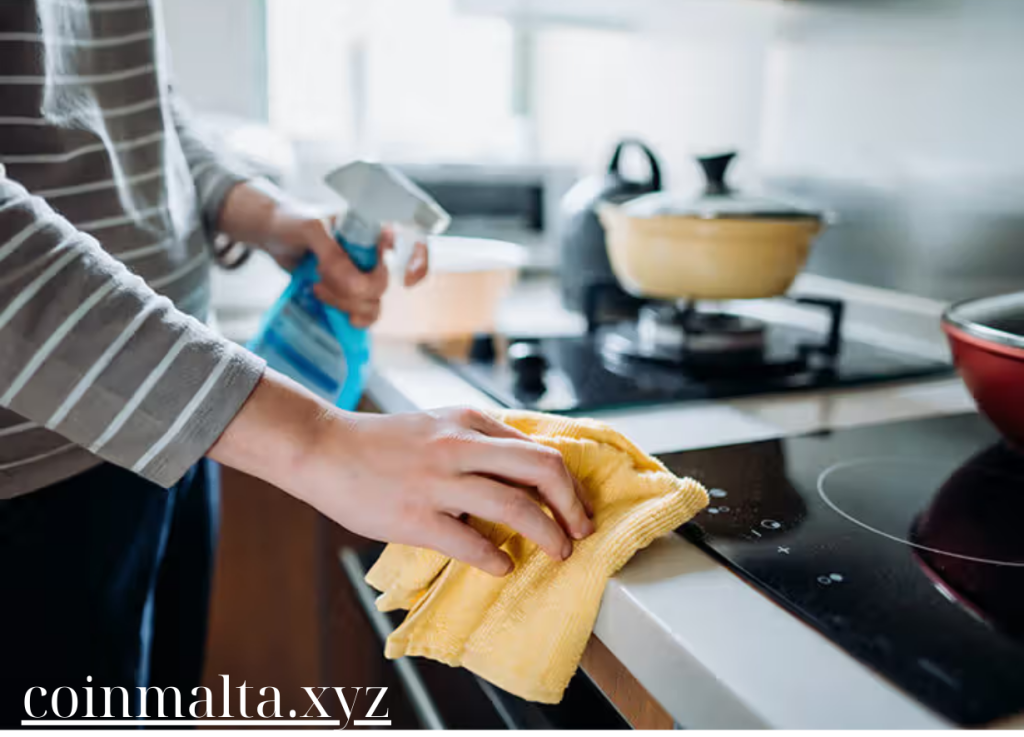Kitchen Hygiene
Cleaning and Sanitizing Kitchen Surfaces: Essential Steps for a Germ-Free Environment
Keeping your kitchen surfaces clean and sanitized is crucial for maintaining a safe and healthy environment. The kitchen is often the heart of the home, where food is prepared, and spills and messes are common. Without proper cleaning, kitchen surfaces can harbor bacteria, viruses, and other harmful pathogens. In this guide, we will outline the essential steps for cleaning and sanitizing kitchen surfaces, ensuring your kitchen stays germ-free and safe for food preparation.
Why Cleaning and Sanitizing Are Important
Cleaning refers to removing visible dirt, food particles, and grease from surfaces, while sanitizing reduces the number of pathogens to safe levels. Both steps are crucial because cleaning alone may not eliminate harmful bacteria, and sanitizing on a dirty surface will be ineffective.
1. Start with Decluttering
Before diving into the cleaning process, it’s important to clear your kitchen surfaces. Remove items like small appliances, cutting boards, and utensils from countertops and other workspaces. This step makes it easier to access all areas and ensures a thorough cleaning process.
- Pro Tip: Place frequently used kitchen items like salt shakers and utensils in a designated area after cleaning to keep surfaces clutter-free moving forward.
2. Cleaning Kitchen Surfaces: The First Step
Once the surfaces are cleared, begin by cleaning them to remove visible dirt, grime, and food particles. Here’s how to properly clean different types of surfaces:
Countertops
- Materials: Use warm, soapy water and a microfiber cloth or sponge.
- Process: Wipe the entire surface, paying extra attention to corners and seams where dirt can accumulate. Rinse the cloth or sponge frequently to avoid spreading debris around.
- For Tough Stains: Apply a mixture of baking soda and water to stubborn spots, let it sit for a few minutes, then scrub gently.
Cutting Boards
- Materials: Dish soap and a scrub brush.
- Process: Clean both sides of the cutting board with hot soapy water. If you’re using wooden cutting boards, avoid soaking them in water as it can cause warping.
- For Stains and Odors: Use lemon juice or vinegar to neutralize strong smells like garlic or onions.
Stovetops
- Materials: Degreasing cleaner or a vinegar and water solution.
- Process: Remove any burners or grates and soak them in hot soapy water. Wipe down the stovetop with a degreaser to remove built-up grease and food residue.
- For Burnt-On Food: Use a baking soda paste to break down tough stains.
3. Sanitizing Kitchen Surfaces: The Second Step
After cleaning, it’s time to sanitize the surfaces to kill germs and bacteria. Here’s how to effectively sanitize your kitchen:
Using a Commercial Sanitizer
- Materials: A commercial kitchen sanitizer or disinfectant approved for food-contact surfaces.
- Process: Apply the sanitizer according to the label instructions, ensuring all surfaces are thoroughly covered. Let it sit for the recommended time before wiping it away with a clean, damp cloth.
- Pro Tip: Look for sanitizers that are food-safe, especially for surfaces like countertops and cutting boards that come into direct contact with food.
DIY Sanitizing Solutions
- Bleach Solution: A common DIY sanitizing solution is a bleach mixture. Use 1 tablespoon of unscented bleach per gallon of water. Apply the solution with a clean cloth or spray bottle, let it sit for at least 1 minute, then rinse thoroughly with water.
- Vinegar and Hydrogen Peroxide: Another effective natural option is spraying surfaces with vinegar followed by hydrogen peroxide. This combination works well for killing bacteria and viruses.
Don’t Forget High-Touch Areas
When sanitizing, focus on areas that are frequently touched, such as:
- Drawer handles and cabinet knobs
- Light switches and appliance handles
- Faucet handles and soap dispensers
4. Sanitizing Kitchen Sponges and Cloths
Kitchen sponges and cloths can be breeding grounds for bacteria, so it’s essential to keep them clean and sanitized. Here are a few methods to ensure they’re germ-free:
- Microwave: Wet the sponge or cloth and microwave it on high for 1-2 minutes. This method kills most bacteria.
- Boiling: Boil sponges or cloths for 5 minutes to sanitize them thoroughly.
- Dishwasher: Run sponges through the dishwasher on a high-heat setting to sanitize them between uses.
Pro Tip: Replace kitchen sponges every two weeks and use separate sponges or cloths for different tasks to avoid cross-contamination.
5. Sanitizing Kitchen Appliances
Your kitchen appliances also need regular cleaning and sanitizing, especially the ones you frequently use for food preparation. Here’s how to sanitize your kitchen appliances:
Refrigerator
- Cleaning: Remove all items and wipe the shelves and drawers with warm, soapy water.
- Sanitizing: Use a vinegar and water solution or a food-safe sanitizer to wipe down all surfaces, including door seals and handles.
- Pro Tip: Place an open box of baking soda in the fridge to absorb odors between cleanings.
Microwave
- Cleaning: Heat a bowl of water with lemon slices for 3-5 minutes. The steam will loosen any stuck-on food particles, making it easy to wipe the interior clean.
- Sanitizing: Wipe down the interior with a food-safe disinfectant or vinegar solution.
Dishwasher
- Cleaning: Run an empty dishwasher with a cup of vinegar to remove buildup.
- Sanitizing: Wipe the exterior and buttons with a sanitizing solution to kill bacteria from frequent touch.
6. Preventing Cross-Contamination in the Kitchen
Cross-contamination can happen when bacteria from raw food, especially meat and poultry, are spread to kitchen surfaces. Here are some tips to prevent this:
- Separate Cutting Boards: Use different cutting boards for raw meats and vegetables. Color-coded boards can help prevent confusion.
- Frequent Handwashing: Always wash your hands after handling raw food, especially when moving between tasks like preparing vegetables and cooking meat.
- Use Disposable Paper Towels: Opt for paper towels to clean up spills from raw meat rather than reusable cloths to avoid spreading bacteria.
7. Cleaning and Sanitizing After Cooking
Once cooking is done, it’s important to clean and sanitize your kitchen thoroughly:
- Wipe down all countertops, cutting boards, and utensils that were used.
- Clean any spills in the oven or stovetop.
- Wash and sanitize your sink, as it’s often a hotspot for germs after food prep.
Conclusion
Maintaining a clean and sanitized kitchen is essential for a germ-free environment, especially in areas where food is prepared. Following the steps for cleaning and sanitizing kitchen surfaces ensures that your kitchen stays safe for your family and reduces the risk of foodborne illnesses. Incorporate these practices into your regular cleaning routine for a healthier, safer kitchen environment.

